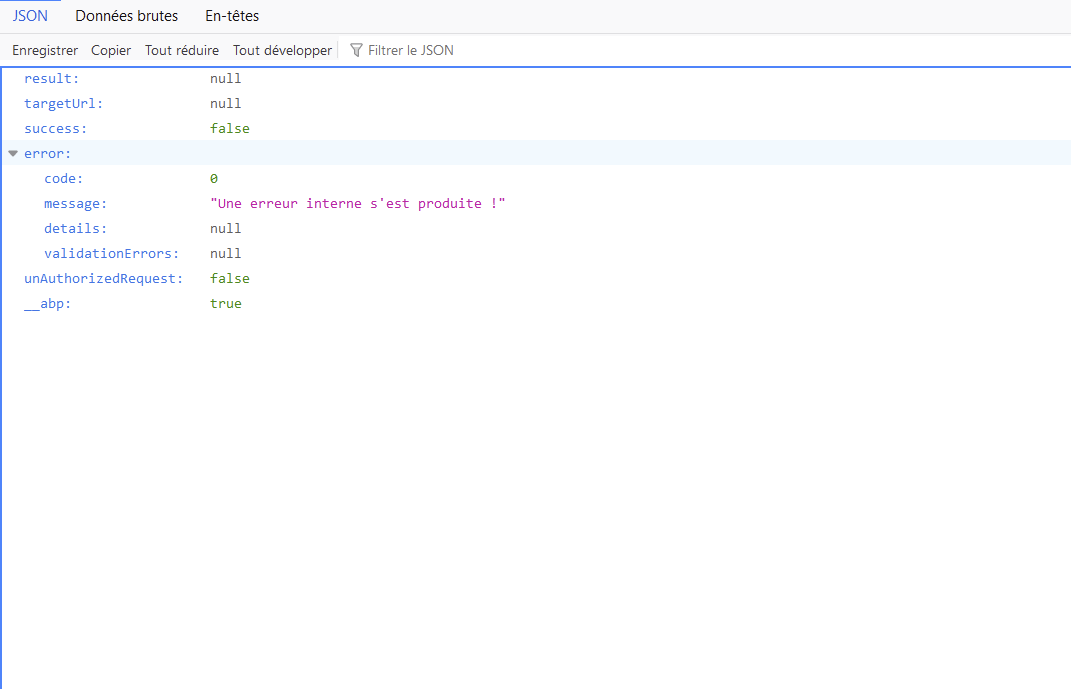Activities of "Bernard"
Hi Yes it’s a single project I still running Yarn
Hi,
**I wanted to know the method of updating a parent's fields after closing a modal is correct or if there is a simpler way: ** var selectedEntityId = $('#MasterDetailChild_Convention_LigneConventionsId').val();
_modalManager.setBusy(true); _ligneConventionsService .createOrEdit(ligneConvention) .done(function () {
abp.notify.info(app.localize('SavedSuccessfully'));
abp.ajax({
type: 'GET',
url: '/api/services/app/Conventions/GetConventionForView',
data: {
id: selectedEntityId
}
}).done(function (data) {
update_TotalHT(data.convention.totalHT.toFixed(2));
update_TotalTVA(data.convention.totalTVA.toFixed(2));
update_TotalTTC(data.convention.totalTTC.toFixed(2));
});
_modalManager.close();
abp.event.trigger('app.createOrEditLigneConventionModalSaved');
}),
Hi What do you mean by server side ?
Hi,
Sorry i don't understand how i can achieve this ?
Thks for your help
Hi,
The OpenconnectId and Microsoft graph connection seems to work well now. But I'm facing another issue now. When I want to view emails I am systemically redirected by this method which seems to pose an issue.
ERUDYEntityFrameworkCoreModule
[DependsOn( typeof(AbpZeroCoreEntityFrameworkCoreModule), typeof(ERUDYCoreModule) )] public class ERUDYEntityFrameworkCoreModule : AbpModule { /* Used it tests to skip DbContext registration, in order to use in-memory database of EF Core */ public bool SkipDbContextRegistration { get; set; }
public bool SkipDbSeed { get; set; }
public override void PreInitialize()
{
if (!SkipDbContextRegistration)
{
Configuration.Modules.AbpEfCore().AddDbContext<ERUDYDbContext>(options =>
{
if (options.ExistingConnection != null)
{
ERUDYDbContextConfigurer.Configure(options.DbContextOptions,
options.ExistingConnection);
}
else
{
ERUDYDbContextConfigurer.Configure(options.DbContextOptions,
options.ConnectionString);
}
});
}
// Set this setting to true for enabling entity history.
Configuration.EntityHistory.IsEnabled = false;
// Uncomment below line to write change logs for the entities below:
// Configuration.EntityHistory.Selectors.Add("ERUDYEntities", EntityHistoryHelper.TrackedTypes);
// Configuration.CustomConfigProviders.Add(new EntityHistoryConfigProvider(Configuration));
}
public override void Initialize()
{
IocManager.RegisterAssemblyByConvention(typeof(ERUDYEntityFrameworkCoreModule).GetAssembly());
}
public override void PostInitialize()
{
var configurationAccessor = IocManager.Resolve<IAppConfigurationAccessor>();
using (var scope = IocManager.CreateScope())
{
if (!SkipDbSeed && scope.Resolve<DatabaseCheckHelper>()
.Exist(configurationAccessor.Configuration["ConnectionStrings:Default"]))
{
SeedHelper.SeedHostDb(IocManager);
}
}
}
}
And the resut email display is :
Have you an idea of what causes this issue ?
Thks very much
Hi Ismail,
I finally found the good way :
// Retrieve required permissions from appsettings string[] initialScopes = configuration.GetValue<string>("DownstreamApi:Scopes")?.Split(' ');
var authenticationBuilder = services.AddAuthentication(options => { options.DefaultScheme = "OpenIdConnect"; options.DefaultChallengeScheme = "AzureAd";
if (bool.Parse(configuration["Authentication:OpenId:IsEnabled"])) { if (bool.Parse(configuration["Authentication:AllowSocialLoginSettingsPerTenant"])) { services.AddSingleton<IOptionsMonitor<OpenIdConnectOptions>, TenantBasedOpenIdConnectOptions>(); }
authenticationBuilder.AddOpenIdConnect(options =>
{
options.ClientId = configuration["Authentication:OpenId:ClientId"];
options.Authority = configuration["Authentication:OpenId:Authority"];
options.SignedOutRedirectUri = configuration["App:WebSiteRootAddress"] + "Account/Logout";
options.ResponseType = configuration["Authentication:OpenId:ResponseType"];
options.TokenValidationParameters = new TokenValidationParameters()
{
ValidateIssuer = bool.Parse(configuration["Authentication:OpenId:ValidateIssuer"])
};
options.Events.OnTokenValidated = context =>
{
var jsonClaimMappings = new List<JsonClaimMap>();
configuration.GetSection("Authentication:OpenId:ClaimsMapping").Bind(jsonClaimMappings);
context.AddMappedClaims(jsonClaimMappings);
return Task.FromResult(0);
};
var clientSecret = configuration["Authentication:OpenId:ClientSecret"];
if (!clientSecret.IsNullOrEmpty())
{
options.ClientSecret = clientSecret;
}
})**.AddMicrosoftIdentityWebApp(options =>
{
options.ClientId = configuration["Authentication:AzureAd:ClientId"];
options.Instance= configuration["Authentication:AzureAd:Instance"];
options.TenantId = configuration["Authentication:AzureAd:TenantId"];
options.SignedOutRedirectUri = configuration["App:WebSiteRootAddress"] + "Account/Logout";
var clientSecret = configuration["Authentication:AzureAd:ClientSecret"];
if (!clientSecret.IsNullOrEmpty())
{
options.ClientSecret = clientSecret;
}
}, null, "AzureAd")
.EnableTokenAcquisitionToCallDownstreamApi(initialScopes)
.AddMicrosoftGraph(configuration.GetSection("DownstreamApi"))
.AddInMemoryTokenCaches();**
};
//MS Graph Authentification services.AddAuthentication().AddMicrosoftIdentityWebApp(configuration.GetSection("AzureAd")) .EnableTokenAcquisitionToCallDownstreamApi(configuration.GetValue<string>("DownstreamApi:Scopes")?.Split(' ')) .AddMicrosoftGraph(configuration.GetSection("DownstreamApi")) .AddInMemoryTokenCaches();
Same issue
I follow your example like :
var authenticationBuilder = services.AddAuthentication();
if (bool.Parse(configuration["Authentication:OpenId:IsEnabled"]))
{
if (bool.Parse(configuration["Authentication:AllowSocialLoginSettingsPerTenant"]))
{
services.AddSingleton<IOptionsMonitor<OpenIdConnectOptions>, TenantBasedOpenIdConnectOptions>();
}
authenticationBuilder.AddOpenIdConnect(options =>
{
options.ClientId = configuration["Authentication:OpenId:ClientId"];
options.Authority = configuration["Authentication:OpenId:Authority"];
options.SignedOutRedirectUri = configuration["App:WebSiteRootAddress"] + "Account/Logout";
options.ResponseType = configuration["Authentication:OpenId:ResponseType"];
options.TokenValidationParameters = new TokenValidationParameters()
{
ValidateIssuer = bool.Parse(configuration["Authentication:OpenId:ValidateIssuer"])
};
options.Events.OnTokenValidated = context =>
{
var jsonClaimMappings = new List<JsonClaimMap>();
configuration.GetSection("Authentication:OpenId:ClaimsMapping").Bind(jsonClaimMappings);
context.AddMappedClaims(jsonClaimMappings);
return Task.FromResult(0);
};
var clientSecret = configuration["Authentication:OpenId:ClientSecret"];
if (!clientSecret.IsNullOrEmpty())
{
options.ClientSecret = clientSecret;
}
});
};
authenticationBuilder.AddMicrosoftIdentityWebApp(configuration.GetSection("AzureAd"))
.EnableTokenAcquisitionToCallDownstreamApi(configuration.GetValue<string>("DownstreamApi:Scopes")?.Split(' '))
.AddMicrosoftGraph(configuration.GetSection("DownstreamApi"))
.AddInMemoryTokenCaches();
but it cause issue
An error occurred while starting the application. InvalidOperationException: Scheme already exists: OpenIdConnect
Microsoft.AspNetCore.Authentication.AuthenticationOptions.AddScheme(string name, Action<AuthenticationSchemeBuilder> configureBuilder) ComponentActivatorException: ComponentActivator: could not instantiate Microsoft.AspNetCore.Authentication.AuthenticationSchemeProvider
Castle.MicroKernel.ComponentActivator.DefaultComponentActivator.CreateInstanceCore(ConstructorCandidate constructor, object[] arguments, Type implType)
InvalidOperationException: Scheme already exists: OpenIdConnect
Microsoft.AspNetCore.Authentication.AuthenticationOptions.AddScheme(string name, Action<AuthenticationSchemeBuilder> configureBuilder)
Microsoft.Extensions.Options.OptionsFactory<TOptions>.Create(string name)
Microsoft.Extensions.Options.UnnamedOptionsManager<TOptions>.get_Value()
Microsoft.AspNetCore.Authentication.AuthenticationSchemeProvider..ctor(IOptions<AuthenticationOptions> options, IDictionary<string, AuthenticationScheme> schemes)
lambda_method47(Closure , object[] )
Castle.Core.Internal.ReflectionUtil.Instantiate(ConstructorInfo ctor, object[] ctorArgs)
Castle.Core.Internal.ReflectionUtil.Instantiate<TBase>(Type subtypeofTBase, object[] ctorArgs)
Castle.MicroKernel.ComponentActivator.DefaultComponentActivator.CreateInstanceCore(ConstructorCandidate constructor, object[] arguments, Type implType)

